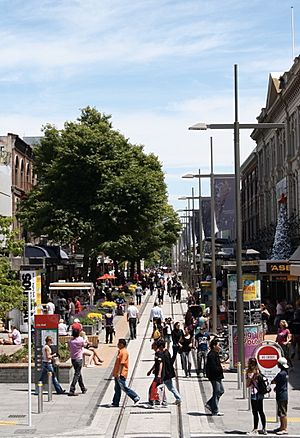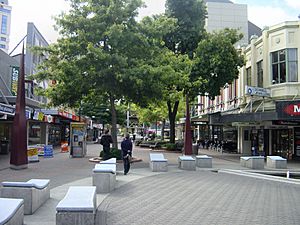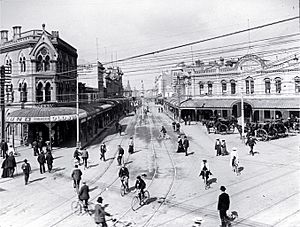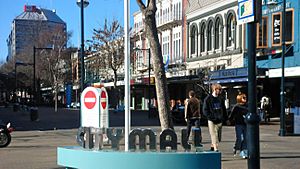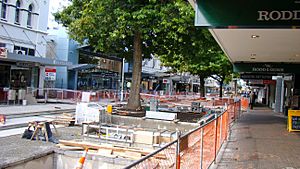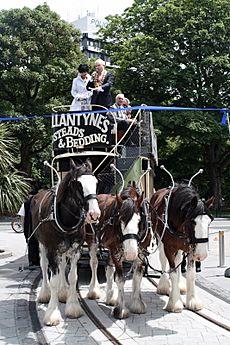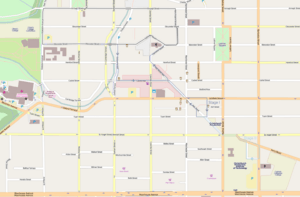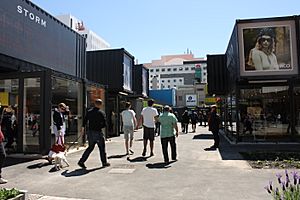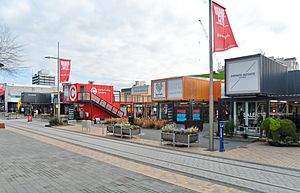City Mall, Christchurch facts for kids
City Mall is a special shopping and walking area in the heart of Christchurch, New Zealand. It's made up of parts of two streets, Cashel Street and High Street, plus the famous Bridge of Remembrance. It's also sometimes called Cashel Mall.
The Bridge of Remembrance became a walking-only area in 1976. Then, on January 11, 1982, the main mall area was closed to cars. It officially opened as a pedestrian mall on August 7, 1982. However, it took until 1992 for the entire area to be fully paved and finished. The mall got a big makeover between 2006 and 2009. During this time, tracks were added for the city's old-fashioned tram system to expand.
Sadly, the 2010 Canterbury earthquake in September caused some damage to buildings. A strong aftershock on Boxing Day, right under the city, caused even more harm. Then, the powerful 6.3 magnitude 2011 Christchurch earthquake in February really devastated the mall. Many building fronts collapsed, and some people sadly lost their lives. The city center had to be closed for a long time so damaged buildings could be safely taken down.
A part of City Mall, the section of Cashel Street from Oxford Terrace to Colombo Street, was the first area of the central city to reopen. This happened on Saturday, October 29, 2011, with a special ceremony led by Prime Minister John Key.
Contents
Exploring City Mall's Location
City Mall includes a section of Cashel Street, which runs from Cambridge Terrace to High Street. It also includes a part of High Street, from Cashel Street to where it meets Hereford and Colombo Streets.
Cashel Street goes from east to west. The part of Cashel Street that is in City Mall is about 400 meters (1,300 feet) long. This street was named after a bishopric (an area managed by a bishop) called Cashel.
High Street is one of the two streets in the city center that run diagonally, from north-west to south-east. The part of High Street in City Mall is about 150 meters (490 feet) long. It was first called Sumner Road because it led to the town of Sumner. Later, it was renamed High Street, possibly after a famous street in Oxford, England.
How City Mall Began
People in Christchurch started counting how many pedestrians (people walking) were in the city center back in 1957. They counted at different spots, and over the years, they noticed fewer people walking in the main areas. For example, in 1957, about 30,000 pedestrians were counted at seven key spots. By 1981, this number had dropped to 18,000.
When City Mall was created, the number of pedestrians went up again to 25,000. This showed that making a special walking area really helped bring people back to the city center.
The Idea for a Pedestrian Mall
The idea for a walking-only mall in Cashel and High Streets first came up in 1965. Around the same time, Wellington was also thinking about creating a pedestrian mall in Cuba Street. Christchurch's plan was included in the city's development scheme in 1968.
A year later, Cuba Mall was successfully opened in Wellington. Its success gave other cities, like Christchurch, the confidence to move forward with their own plans. In 1976, the Bridge of Remembrance was closed to cars, making the short link over the Avon River a walking-only path. The plans for City Mall were confirmed in 1979.
On January 11, 1982, the parts of Cashel and High Street that would become the mall were closed to traffic. The mayor at the time, Hamish Hay, officially opened the City Mall project on August 7, 1982. This first stage cost about NZ$0.5 million. It took ten years and three different stages to fully pave the entire area. Trees and more seating were added in the final stage in the early 1990s. Mayor Vicki Buck opened this final stage on December 4, 1992.
Later, in 1998, the area next to the mall, Oxford Terrace, was redeveloped and became known as The Strip. It was a popular place for night-time entertainment for about ten years. Another pedestrian mall inspired by City Mall was New Regent Street. It was closed to cars in 1994 to prepare for the return of the Christchurch tram.
Modern Makeover (2007–2009)
In 2006, the public was asked for their ideas on how to redevelop City Mall. The Council approved the plans in December 2006. They had set aside NZ$10.5 million for the project, but it ended up costing NZ$14 million. The work began on August 10, 2007.
A separate project that affected City Mall was the extension of the heritage tramway. The plan was for the trams to travel through parts of City Mall on Cashel Street and High Street. This tram project was expected to cost NZ$10.8 million.
The redevelopment had some disagreements. Young people protested when a spot called Hack Circle was removed. This area was a popular gathering place for them. There were also protests when the Stewart Fountain was taken down. This fountain, built in 1998, was decorated with tiles painted by Christchurch schoolchildren. The demolition of the fountain began on August 13, 2007. The area where the fountain was is now called Stewart Plaza.
Another point of discussion was a "slow road" planned for High Street. Even though many people disagreed with it, the Council decided to go ahead. The newly upgraded City Mall was officially opened by Mayor Bob Parker on December 18, 2009.
Earthquakes and Rebuilding (2010-2011)
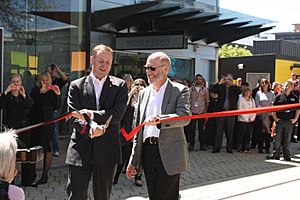
After the big 7.1 magnitude 2010 Canterbury earthquake on September 4, 2010, the city center was closed for a week. Some buildings were damaged. An aftershock on Boxing Day 2010, though smaller, caused more damage because it was directly under the city. For example, a restaurant on Cashel Street had its roof crushed by a falling wall from a nearby building. Luckily, the restaurant was closed at the time.
The 6.3 magnitude 2011 Christchurch earthquake on February 22, 2011, caused much more severe damage. It was closer to the city center and led to many buildings being lost. Sadly, several people lost their lives in City Mall due to falling debris. The central city was completely closed off so that dangerous buildings could be safely taken down.
In April 2011, it was announced that a part of Cashel Street would reopen on October 29, 2011. Temporary shops made from shipping containers were set up. These 27 shops became known as . Ballantynes, Christchurch's main department store, also reopened and became a key shop in the area. Prime Minister John Key attended the opening ceremony.
The people who organized the container mall first said it was the world's first "pop-up mall." However, there were already similar container malls in other places around the world. The Canterbury Earthquake Recovery Authority removed the remaining cordons (closed-off areas) around City Mall in June 2013, allowing full access again.
Historic Buildings in City Mall
City Mall has, or used to have, seven buildings that were recognized as important historic places by Heritage New Zealand. Here are some of them, starting from the High Street end and moving along Cashel Street:
| Photo | Name | Status | Address | Description |
 |
Fisher's Building | Demolished | 280 High Street | A commercial building designed by William Armson. |
 |
D.I.C. Building | Demolished | 154–158 Cashel Street | A former department store building from 1909. |
 |
Beaths Department Store Building | Still standing | 682–690 Colombo Street; corner Cashel Street | This building is now part of the Bus Exchange. |
 |
Guthrey Centre | Demolished | 124–126 Cashel Street | A commercial building from around 1881, also designed by William Armson. |
 |
Twentymen & Cousins Store | Demolished | 93 Cashel Street | A commercial building from 1882. |
 |
Zetland Hotel | Demolished | 88–92 Cashel Street | A former hotel from 1903. |
 |
Bridge of Remembrance | Repairs completed April 2016 | Between Oxford and Cambridge Terraces | A war memorial from World War I. |


